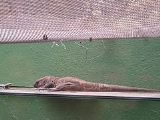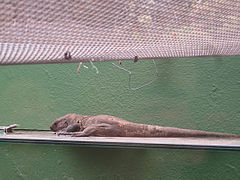
El Hierro Giant Lizard
Encyclopedia

Species
In biology, a species is one of the basic units of biological classification and a taxonomic rank. A species is often defined as a group of organisms capable of interbreeding and producing fertile offspring. While in many cases this definition is adequate, more precise or differing measures are...
of lacertid (wall lizard
Lizard
Lizards are a widespread group of squamate reptiles, with nearly 3800 species, ranging across all continents except Antarctica as well as most oceanic island chains...
) that can be found on the island of El Hierro
El Hierro
El Hierro, nicknamed Isla del Meridiano , is the smallest and farthest south and west of the Canary Islands , in the Atlantic Ocean off the coast of Africa, with a population of 10,162 .- Name :The name El Hierro, although phonetically identical to the Spanish word for 'iron', is generally thought...
, one of the Canary Islands
Canary Islands
The Canary Islands , also known as the Canaries , is a Spanish archipelago located just off the northwest coast of mainland Africa, 100 km west of the border between Morocco and the Western Sahara. The Canaries are a Spanish autonomous community and an outermost region of the European Union...
. The species was once present throughout much of the island and on the small offshore Roque Chico de Salmor, but is now confined to a few small areas of cliff with sparse vegetation. It is currently restricted to the southern end of the Risco de Tibataje in la Fuga de Gorreta, located between Guinea and the so-called Paso del Pino (an area of about four hectare
Hectare
The hectare is a metric unit of area defined as 10,000 square metres , and primarily used in the measurement of land. In 1795, when the metric system was introduced, the are was defined as being 100 square metres and the hectare was thus 100 ares or 1/100 km2...
s). The species was also successfully reintroduced to the Roque Chico de Salmor in 1999, and subsequent reintroductions have taken place at Julan and at la Dehesa.(Miras & Pérez-Mellado 2005b)
About two feet (0.6 m) long, the Hierro Giant Lizard is a thickset reptile
Reptile
Reptiles are members of a class of air-breathing, ectothermic vertebrates which are characterized by laying shelled eggs , and having skin covered in scales and/or scutes. They are tetrapods, either having four limbs or being descended from four-limbed ancestors...
with a broad head. Adults are dark grey to brown in colour, with two rows of pale orange patches running along its sides. Its belly is mostly brown, but has an orange to red colouration towards the middle. Older El Hierro Giant Lizards are mainly black with some grey. Males are larger than females.
The Hierro Giant Lizard is omnivorous. It eats plants - notably verode and Lavandula abrotanoides - as well as insects (ARKive 2006). Mating begins in May and the 5 to 13 eggs are laid from June until the end of August. Their eggs hatch after 61 days.
Systematics
Two subspeciesSubspecies
Subspecies in biological classification, is either a taxonomic rank subordinate to species, ora taxonomic unit in that rank . A subspecies cannot be recognized in isolation: a species will either be recognized as having no subspecies at all or two or more, never just one...
are recognised:
- Roque Chico de Salmor Giant LizardRoque Chico de Salmor Giant LizardThe Roque Chico de Salmor Giant Lizard was the nominate subspecies of the lacertid Gallotia simonyi. It was once present on a small islet near El Hierro in the Canary Islands....
, Gallotia simonyi simonyi - extinct (c.1930s) - El Hierro Giant Lizard or Hierro Giant Lizard , Gallotia simonyi machadoi
Previously, Gallotia simonyi included the La Palma Giant Lizard
La Palma Giant Lizard
The La Palma Giant Lizard is a giant lacertid historically living in the island of La Palma ; its habitat ranged from sea level up to altitudes of 800 m....
and the La Gomera Giant Lizard
La Gomera Giant Lizard
The La Gomera Giant Lizard is a lacertid species that can be found on the island of La Gomera, one of the Canary Islands....
as subspecies too (Miras 2005, Miras & Pérez-Mellado 2005a); the latter is known to be very closely related to the extant population (Maca-Meyer et al. 2003) and its specific distinctness is not universally accepted (e.g. Bischoff 2000). Subfossil
Subfossil
Subfossil refers to remains whose fossilization process is not complete, either for lack of time or because the conditions in which they were buried were not optimal for fossilization....
remains from El Hierro that were assigned to the prehistorically extinct Gallotia goliath
Gallotia goliath
Gallotia goliath is an extinct giant lizard species from the island of Tenerife of the Canary Islands, Spain. This reptile lived before the arrival of humans. It was described by the German herpetologist Robert Mertens. It is believed that it grew to at least three feet long...
apparently belong to the present species (Barahona et al. 2000), but the population referred to G. goliath from Tenerife
Tenerife
Tenerife is the largest and most populous island of the seven Canary Islands, it is also the most populated island of Spain, with a land area of 2,034.38 km² and 906,854 inhabitants, 43% of the total population of the Canary Islands. About five million tourists visit Tenerife each year, the...
was distinct (Maca-Meyer et al. 2003).
Status and conservation
The nominate subspecies Gallotia simonyi simonyi was only known from the Roque Chico de Salmor, a small islet off northwestern Valverde municipalityValverde, Santa Cruz de Tenerife
Valverde is a municipality in the Canary Islands in the province of Santa Cruz de Tenerife. It is located on the north-east part of El Hierro . The town of the same name serves as the island's official capital...
. It disappeared around the 1930s through unsustainable collecting of animals for scientific institutions and commercial interests, as well as predation by feral cats and possibly Herring Gulls (Diaz & Bischoff 1994, Miras & Pérez-Mellado 2005b). Following this population's disappearance, the species was believed to be entirely extinct.
In 1974, the German amateur herpetologist Werner Bings discovered a surviving population of this species on El Hierros mainland (Böhme & Bings 1975). This was subsequently determined to be a distinct subspecies, 100 years after the species was first described (López-Jurado 1989).
The population of this species is about 300 to 400 animals in the wild (including re-introduced populations), and it is classified as Critically Endangered by the 2006 IUCN Red List
IUCN Red List
The IUCN Red List of Threatened Species , founded in 1963, is the world's most comprehensive inventory of the global conservation status of biological species. The International Union for Conservation of Nature is the world's main authority on the conservation status of species...
. This giant lizard's major threat is predation by feral cats, and possibly also by dogs and rats
RATS
RATS may refer to:* RATS , Regression Analysis of Time Series, a statistical package* Rough Auditing Tool for Security, a computer program...
.
A recovery plan for the Hierro Giant Lizard has been developed and the United Nations
United Nations
The United Nations is an international organization whose stated aims are facilitating cooperation in international law, international security, economic development, social progress, human rights, and achievement of world peace...
and the Canary Islands Autonomous Government funded a program for the captive breeding and re-introduction of the Hierro giant lizard to its original natural habitat, including the Roque Chico de Salmor. Control of feral cats has been stopped in 2002, but according to the IUCN continued control of feral cats should be resumed to allow population recovery.
The Hierro Giant Lizard is protected by national and international legislation. It is listed on Annex IV of the European Union
European Union
The European Union is an economic and political union of 27 independent member states which are located primarily in Europe. The EU traces its origins from the European Coal and Steel Community and the European Economic Community , formed by six countries in 1958...
's Habitats Directive (EC 2003) and on Appendix I of CITES.
External links
- lacerta.de: Gallotia simonyi machadoi image gallery. Retrieved 2007-FEB-25.

